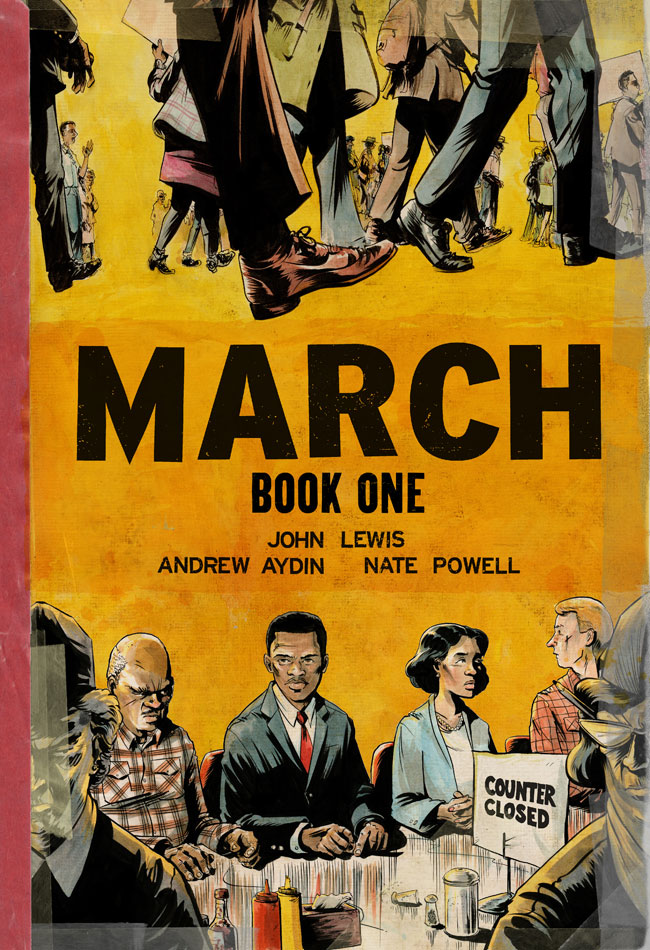“Some of you may be asking: ‘Hey, John Lewis, why are you trying to write a comic book?’” said the legendary civil rights leader, smiling at the incongruity of this development for an audience at Book Expo America, the annual publishing trade show in Manhattan.
John Lewis was 17 when he met Rosa Parks; 18 when he joined forces with the Rev. Dr. Martin Luther King, Jr. Five years later, he was one of the “big six,” an architect of the historic Civil Rights March on Washington in August 1963. Standing at the Lincoln memorial, Lewis spoke sixth and King spoke tenth, stamping the day with his immortal “I Have a Dream.” Of all those who addressed the throng a half century ago, Lewis is the only one left.
Now, at 73, he has become the first member of the U.S. Congress to craft a comic book. Called “March,” it will publish August 13, the first in a trilogy written with Lewis staff member Andrew Aydin and drawn by Nate Powell, the award-winning cartoonist.
The idea isn’t as whimsical as it sounds. Aydin, a comic book enthusiast from Atlanta, knew that in 1957, a 15-cent comic entitled “Martin Luther King and the Montgomery Story” inspired the Greensboro Four. At least one read the comic and the four students from North Carolina A&T State University decided to sit down in protest at the segregated Woolworth’s lunch counter in Greensboro, N.C.
Lewis himself led a group trying to integrate a Woolworth’s counter Feb. 27, 1960. They prayed and drew on the principles of non-violence. “People came up to us and spit on us and put cigarettes out in our hair,” he told listeners at the Book Expo. “I was so afraid, I felt liberated.” The episode led to jail, the first of Lewis’s more than 40 civil rights arrests.
He grew up on 110 acres in rural Alabama, the third child of sharecroppers who managed to buy the land for $300 in 1940. Young John liked to wear a tie and give sermons to the chickens. Local kids called him “preacher.” As a boy, he was instructed “not to get in the way” of whites, but he still applied for a library card in tiny Troy, Ala, where the librarian scolded him that they were only for whites.
On July 5, 1998, Lewis returned to Troy, for a book signing of his memoir, “Walking with the Wind,” which won an Anisfield-Wolf Book Award that year. “At the end of the program, they gave me a library card,” he said. “It says something about how far we’ve come.”
Lewis said he initially resisted Aydin’s notion that he tell his story in a graphic format. The two were hammering up yard signs in southwest Atlanta during Lewis’ campaign for Georgia’s 5th District seat five years ago and chatting about how to teach the Civil Rights movement to 21st century youth.
“Finally, he turned around with that wonderful half-smile he can do and said, ‘OK, let’s do it,’” said Aydin. “‘Let’s do it, but only if you do it with me.’ ” Aydin called this a threshold event in his life.
Watch a short interview with John Lewis and Aydin at the 2013 Book Expo America
“When you grow up without a father you spend a long part of your adolescence looking for one,” said Aydin, who is now 29. He and artist Powell said “Walking with the Wind” became their Bible as they brought Lewis’ story into the present. The trio frame the trilogy around the 2009 inauguration of Barack Obama.
“We took the accuracy very, very seriously,” Aydin said. Powell, who grew up in Little Rock, Ark., and now lives in Bloomington, Ind., is drawing the second book now. He said he emails with Aydin almost daily, and when they are unclear, they consult Lewis.
“I feel the most important thing is to capture what is not explicit in the script,” Powell, 34, said. “I am looking for the emotional resonance – the doubt, fear, unity and togetherness that characterize the Civil Rights movement but don’t come with captions.”
He said he works hard researching the clothes, food, insects and plants that give his art verisimilitude. “It is very easy to get caught up in the drama of events,” Powell said, “but there is a lot of beauty in the South, in the red soil and the bricks, the kind of walking and talking people in the South do.”
Already, Powell has told one Civil Rights story in graphic form, “The Silence of Our Friends,” set in Houston in 1967 and written by Mark Long. It explores the tested friendship of two men across race.
The Congressman dedicates “March” to “the past and future children of the movement.” He told the publishing crowd in New York that another installment is overdue.
“I believe it is time to do a little more marching,” Lewis said. “I believe it is time for us to move our feet… I hope that this book will inspire another generation of people to get in the way, find a way to get into trouble, good trouble, necessary trouble.”




Anisfield-Wolf Book Awards | Congressman John Lewis Urges Cleveland State Graduates To “Be Good Citizens Of The World”
December 17, 2013
[…] but citizens of the world,” Lewis said, connecting his listeners to Mandela’s legacy and the American Civil Rights movement. “This is your day, not mine,” he said, with more than the snowy date on the calendar in […]